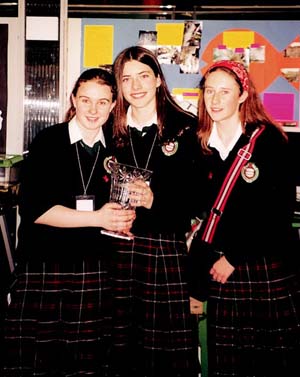| 2004 |

|
YEAR BOOK |
Presentation Secondary School, Loughboy, Co. Kilkenny
|
River aeration giving fish a breath of fresh air
|

The area of the river Nore that we studied is in Inch Mills, Co. Kilkenny. The sawmill has two turbines and the only fully functional millwheel in Ireland. While visiting the mill, we noticed the water leaving the millwheel was white and foamy, whereas the water leaving the turbines remained clear. We found out that this was because the water was being aerated, so we based our project on this.
Our objectives were to prove scientifically (i.e. to do research and to carry out experiments) that waterwheels and specially adapted turbines can effectively aerate rivers while providing clean renewable energy. To do this, we carried out a number of experiments regarding the waterwheel and the turbines. In these tests, we took water samples from before and after the millwheel and before and after the turbines. With these samples, we used an oximeter to measure the dissolved oxygen content in the water.
We realised that waterwheels, which were built to produce hydroelectric energy, can raise dissolved oxygen levels by 10%. This increase in dissolved oxygen level, however, only occurs if the blades of the wheels are curved. When the blades are curved, the water is aerated due to the Coanada effect, which means the water will follow the curve of the blade. We also found that turbines do not normally aerate water but can be adapted to do so. We adapted the turbines at Inch mills by inserting a pipe into the vacuum on the turbine. This meant air was being sucked in with the water, which in turn aerated the water. This was based on the Bernoulli effect, which means that, when the pressure decreases, the speed of the water increases. By adapting the turbines like this, we raised the dissolved oxygen levels by 10%.
Based on our conclusions, we think that all turbines should be specially adapted to aerate the water and that all waterwheels should be built with curved blades.
Emma Nolan, Laura O'Neill & Tara Mc Grath, who entered their project in the Junior Group Section in the Biological and Ecological Sciences Category at the EsatBT Young Scientist & Technology Exhibition in January 2004, won a Special Award sponsored by Sustainable Energy Ireland. Their teachers were Ms Joan Cashin & Ms Maruna Mahon.
| This article was sponsored by Sustainable Energy Ireland |
|---|